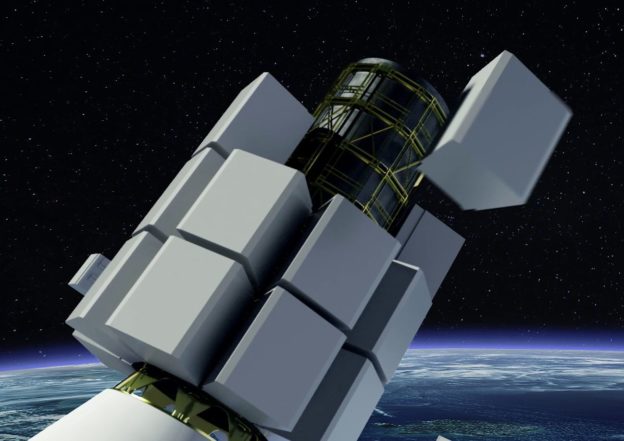Welcome to Tesla Motors Club
Discuss Tesla's Model S, Model 3, Model X, Model Y, Cybertruck, Roadster and More.
Register
Install the app
How to install the app on iOS
You can install our site as a web app on your iOS device by utilizing the Add to Home Screen feature in Safari. Please see this thread for more details on this.
Note: This feature may not be available in some browsers.
-
Want to remove ads? Register an account and login to see fewer ads, and become a Supporting Member to remove almost all ads.
You are using an out of date browser. It may not display this or other websites correctly.
You should upgrade or use an alternative browser.
You should upgrade or use an alternative browser.
I noticed the Iridium satellites and the GRACE sats both are very similar in shape and size (minus the Iridium solar arrays). Were they built by the same company or just a coincidence?
To add to @Grendal's response, the trapezoidal cross section is a pretty common form-factor for mid-sized spacecraft. Its basically a solution the square peg in a round hole problem. It fleshes out as the ideal way to maximize spacecraft volume when packaging a number of identical spacecraft in a fairing on a cylindrical dispenser (a form factor that itself is also pretty ideal). A major benefit to this trapezoidal form factor is that you also maximize your earth-facing surface area and thus typically don't need a large amount of deployables (which of course is cheaper and more reliable).
Here's the second gen Globalstars. First Gen were basically the same size and shape. This particular launch was a Soyuz that could only lift 6 units, which is why the upper dispenser (on the right) is conical (not cylindrical) and only has two spacecraft.
Iridium, for reference:
Here's a Oneweb, plus a rendering of them mounted on a dispenser. Note that while the actual size is smaller, the form factor of the spacecraft and dispenser still hold true:


SpaceX does not use explosive bolts, they use spring-loaded clamps, I think. When the clamp release is triggered electrically the spring expands and gently pushes the satellite away from its mount.how they are released?
I think some of the clamps are activated by high pressure Helium, but that might just be the fairing.SpaceX does not use explosive bolts, they use spring-loaded clamps, I think. When the clamp release is triggered electrically the spring expands and gently pushes the satellite away from its mount.
Mike1080i
Member
Yes, Mercury had it's abort tests on Little Joe boosters and Apollo flew it's abort tests on Little Joe II. Then there was the unplanned test on the actual Mercury-Atlas 3 test flight. The Atlas failed to initiate it's pitch and roll sequence to head downrange and instead just continued flying straight up... until the RSO (range safety officer) sent the destruct signal. The launch escape system did it's job and the spacecraft splashed down just off the beach, and was reflown on MA-4.Has NASA or anyone ever done an in-flight abort test?
Last edited:
Wow, literally! Looks like about 100m offshore.The launch escape system did it's job and the spacecraft splashed down just off the beach...
Not that different from SpaceX abort test. That landed only about 100m offshore. 18:40 in the video.Wow, literally! Looks like about 100m offshore.
Hopefully not by pyrotechnics and breaking bolts?
You're not going to be happy.
Actually, I don't know the exact holddown and release mechanism for the Iridium spacecraft, but its likely not a pyro device. Its hard to beat the capability and reliability of powder with bigger things (like releasing X000 kg spacecraft), but with smaller spacecraft like Iridium there are a number of different solutions. Most likely they use a fairly common split spool device. In super basic and not-actually-right terms, imagine if you cut a nut in half, then bound it back together by wrapping a large watch-spring around the outside. Designed correctly, with extremely little effort you can hold that spring in place and your nut would be able to hold pretty decent load in a corresponding bolt. When you want to release the tension in that bolt you just have to "let go" of the spring. The spring then then unravels, allowing the nut halves to separate, and then the bolt is free. "Let go" can happen in a few different ways, the most basic is running current through a thin wire that is holding the spring in place. Run enough current through and the wire melts, releasing the spring.
There are also full electronic actuators used for releasing spacecraft, but typically they don't have the load capacity of something like an Iridium-sized spacecraft. There are also solutions that stretch bolts (by heating them) to failure, but to my knowledge those haven't' been used for releasing spacecraft.
In all cases of space deployables, from pyros to spools to servos, varying shapes, sizes, and quantities of springs (leaf, coil, torsion) are used to actually create the motion of separation/deployment. Its super cool when you start tuning those springs asymmetrically to induce tumbles and such.
Similar threads
- Replies
- 15
- Views
- 984
- Replies
- 9
- Views
- 642


